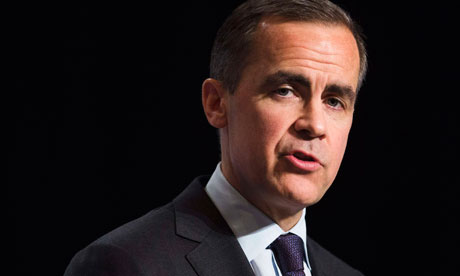Has quantitative easing had its day?
QE's failure to power recovery is clear, but the US and UK remain wedded to the policy to stifle debate about fiscal policy

Mark Carney, governor-elect of the Bank of England, wants to retain QE as the chief policy instrument for engineering recovery. Photograph: Mark Blinch/Reuters
Last autumn the chairman of the US Federal Reserve, Ben Bernanke, ended months of speculation about whether there would be another round of quantitative easing – the policy of buying up securities from banks so that more money is injected into the financial system. The idea has been that this will get them lending more and powering a recovery. Since the first two rounds had patently failed to generate recovery, he now announced a QE3 with a difference: not only did he announce QE3, its sheer scale and boundlessness made it a veritable QE infinity. The Fed would continue buying up mortgage-backed securities to the tune of $40bn a month until the labour market improved and would keep interest rates to their current near-zero levels until unemployment fell below 6.5%.
Having targeted inflation to please the holders of capital for almost two decades, even when the resulting high interest rates stifled investment and kept unemployment high, the Fed's concern about employment was certainly novel. To be sure, it is mandated to keep both inflation and unemployment low, but until now it had succeeded in finessing this mandate and concentrating more or less exclusively on keeping the former alone in check.
Meanwhile, the UK's new central banker in waiting, Mark Carney, proposed his own innovation in monetary policy: the Bank of England's two-decade-old policy of targeting inflation should be dropped in favour of targeting nominal GDP growth. This would keep up liquidity injections into the financial system until targeted nominal growth materialised. He did not say what he would do if the nominal growth target yielded more inflation than growth. Discussion centred on whether the Bank of England's mandate would be revised. Both David Cameron and Vince Cable appeared open to the concept.
Bernanke and Carey's new and improved monetary policies are designed to retain QE as the chief policy instrument for engineering recovery despite its failure so far. Given that its most vocal opponents are the economic neanderthals of the US Tea Party right, it is usually assumed that QE is progressive, if not, so far at least, very effective.
In reality, QE has served, first and foremost, to socialise the losses of the financial systems of the two countries at the centre of the financial crisis, the US and the UK. In contrast to the publicly fought over Troubled Asset Relief Program (TARP), QE contributed far more to achieving that objective and did so without the fuss and melodrama of Treasury secretaries going on bended knee before House speakers to beg its passage.
Some find consolation in the thought that at the very least QE prevented the economies of these two countries from falling into outright depression. In reality, two other things accomplished this. First, unlike in the 1930s, the "automatic stabilisers" – government spending and transfers – formed a floor beneath which the economy could not fall. Second, there were mild fiscal stimuli. But their end now threatens to send economic activity south again in both economies.
Indeed, insofar as QE was part of a wider set of policy choices that focused on relieving financial institutions of their irresponsibly extended loans but not the households and firms, QE ensured that a highly leveraged private sector would be unable to borrow, whether to invest or consume. It would also ensure that the resulting demand conditions would deter even the comparatively unleveraged from borrowing to invest.
So we shouldn't assume that QE will power a recovery. It probably won't. As Keynes pointed out, under certain conditions (such as those today: rock-bottom interest rates, poor demand outlook, heavily leveraged firms and households) credit easing would amount to little more than "pushing on a string". So why are Bernanke and Carney seeking to tie recovery even tighter to monetary policy with their innovations in QE precisely when its failure to power recovery is clearer than ever?
It's because without some action on their part, public discussion is bound to turn towards the alternative: a vigorously expansionary fiscal policy, with massively increased state investment in the economy. This option lies just below the surface of public discourse: the neoliberal triumph of recent decades was never able to entirely eradicate it from public discourse and memory. But as long as the public can be kept believing that monetary policy will achieve some semblance of growth, later if not sooner, that the economy's managers are busy refining monetary policy tools to accomplish that, fiscal policy can be that much more effectively kept out of the picture.
In effect the public in both these countries is being told that they cannot get recovery unless the banks give it to them. And keeping recovery hostage to the financial system is tied up with something very fundamental. Announcing the failure of monetary policy is to displace that holy of holies – the private sector – from its current centrality in our understanding of the economy and admitting that government action and expenditure, probably on a large and unprecedented scale, is necessary for recovery.
Having targeted inflation to please the holders of capital for almost two decades, even when the resulting high interest rates stifled investment and kept unemployment high, the Fed's concern about employment was certainly novel. To be sure, it is mandated to keep both inflation and unemployment low, but until now it had succeeded in finessing this mandate and concentrating more or less exclusively on keeping the former alone in check.
Meanwhile, the UK's new central banker in waiting, Mark Carney, proposed his own innovation in monetary policy: the Bank of England's two-decade-old policy of targeting inflation should be dropped in favour of targeting nominal GDP growth. This would keep up liquidity injections into the financial system until targeted nominal growth materialised. He did not say what he would do if the nominal growth target yielded more inflation than growth. Discussion centred on whether the Bank of England's mandate would be revised. Both David Cameron and Vince Cable appeared open to the concept.
Bernanke and Carey's new and improved monetary policies are designed to retain QE as the chief policy instrument for engineering recovery despite its failure so far. Given that its most vocal opponents are the economic neanderthals of the US Tea Party right, it is usually assumed that QE is progressive, if not, so far at least, very effective.
In reality, QE has served, first and foremost, to socialise the losses of the financial systems of the two countries at the centre of the financial crisis, the US and the UK. In contrast to the publicly fought over Troubled Asset Relief Program (TARP), QE contributed far more to achieving that objective and did so without the fuss and melodrama of Treasury secretaries going on bended knee before House speakers to beg its passage.
Some find consolation in the thought that at the very least QE prevented the economies of these two countries from falling into outright depression. In reality, two other things accomplished this. First, unlike in the 1930s, the "automatic stabilisers" – government spending and transfers – formed a floor beneath which the economy could not fall. Second, there were mild fiscal stimuli. But their end now threatens to send economic activity south again in both economies.
Indeed, insofar as QE was part of a wider set of policy choices that focused on relieving financial institutions of their irresponsibly extended loans but not the households and firms, QE ensured that a highly leveraged private sector would be unable to borrow, whether to invest or consume. It would also ensure that the resulting demand conditions would deter even the comparatively unleveraged from borrowing to invest.
So we shouldn't assume that QE will power a recovery. It probably won't. As Keynes pointed out, under certain conditions (such as those today: rock-bottom interest rates, poor demand outlook, heavily leveraged firms and households) credit easing would amount to little more than "pushing on a string". So why are Bernanke and Carney seeking to tie recovery even tighter to monetary policy with their innovations in QE precisely when its failure to power recovery is clearer than ever?
It's because without some action on their part, public discussion is bound to turn towards the alternative: a vigorously expansionary fiscal policy, with massively increased state investment in the economy. This option lies just below the surface of public discourse: the neoliberal triumph of recent decades was never able to entirely eradicate it from public discourse and memory. But as long as the public can be kept believing that monetary policy will achieve some semblance of growth, later if not sooner, that the economy's managers are busy refining monetary policy tools to accomplish that, fiscal policy can be that much more effectively kept out of the picture.
In effect the public in both these countries is being told that they cannot get recovery unless the banks give it to them. And keeping recovery hostage to the financial system is tied up with something very fundamental. Announcing the failure of monetary policy is to displace that holy of holies – the private sector – from its current centrality in our understanding of the economy and admitting that government action and expenditure, probably on a large and unprecedented scale, is necessary for recovery.

No comments:
Post a Comment